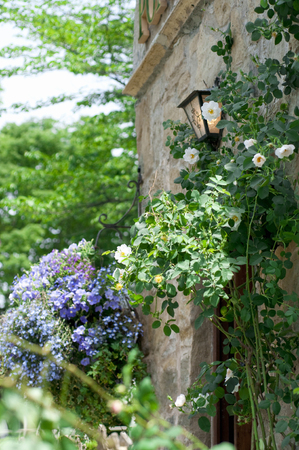Introduction to the British Spade
The British spade is far more than just a practical tool; it is an enduring symbol of the nation’s horticultural legacy. Deeply woven into the fabric of British gardening and landscaping traditions, the spade reflects centuries of craftsmanship, local ingenuity, and cultural pride. From the sprawling estates of the English countryside to the compact urban allotments of London, traditional British spades have played a pivotal role in shaping gardens that are celebrated both for their beauty and their historical resonance. The classic design—characterised by its sturdy wooden handle, forged steel blade, and balanced proportions—has become iconic, representing not only utility but also a connection to generations past. Exploring the heritage of the British spade provides insight into how local customs, environmental demands, and evolving aesthetic preferences have influenced garden tools over time. As we examine the significance of this humble implement, we begin to appreciate its role as a cultural artefact as much as a tool for digging deep into British soil.
Anatomy of the Traditional British Spade
When delving into the world of British gardening tools, the traditional spade stands out as a symbol of both functionality and heritage. Distinct from modern alternatives, the classic British spade is defined by a unique combination of design elements, materials, and craftsmanship that have evolved over centuries. Understanding these features not only highlights their enduring appeal but also sheds light on regional variations across the UK.
Key Design Features
Traditional British spades are immediately recognisable by their robust construction and balanced proportions. The blade is typically flat or slightly curved with a squared or rounded tip, optimised for cutting through heavy soils commonly found in British gardens. The handle is often longer than continental counterparts, providing greater leverage and ergonomic comfort for prolonged use. A signature element is the “T” or “D” shaped grip, which offers excellent control and reflects regional preferences—“T” grips are more common in northern England and Scotland, while “D” grips prevail in the south.
Materials Used
The choice of materials in traditional British spades underscores their durability and time-honoured quality. Blades are usually forged from carbon steel, prized for its strength and ability to retain a sharp edge through repeated use. Handles are predominantly crafted from ash wood—a native British hardwood valued for its flexibility and resilience. Below is a summary table comparing typical materials:
| Component | Common Material | Key Attributes |
|---|---|---|
| Blade | Carbon Steel | Strong, durable, holds edge well |
| Handle | Ash Wood | Flexible, shock-absorbing, lightweight |
| Grip | Ash or Beech Wood/Metal (occasionally) | Ergonomic shaping, regional variation |
Craftsmanship and Regional Variations
The hallmark of the traditional British spade lies in its handcrafted quality. Many classic examples are individually forged and assembled by skilled artisans, ensuring each tool meets exacting standards. Regional differences further distinguish British spades: for instance, Cornish spades often feature narrower blades suited to stony soils, while Kentish designs favour wider blades for clay-rich ground. Handle lengths may also vary based on local digging techniques and soil conditions.
Summary of Regional Variations
| Region | Blade Shape/Size | Handle Type/Length | Notable Features |
|---|---|---|---|
| Cornwall & Devon | Narrower blades | T-grip, medium length | Designed for rocky soils |
| Kent & South East England | Wider blades | D-grip, longer handles | Optimised for clay soils |
| Northern England & Scotland | Slightly curved blades | T-grip, longer handles | Suited to peat and heavy loams |
| The Midlands | Standard rectangular blades | D-grip, standard length | Versatile all-rounders |
The Enduring Legacy of Craftsmanship
The continued use and appreciation of traditional British spades reflect a deep respect for practical design and artisanal skill. These tools not only embody regional identities but also set a benchmark against which modern alternatives are measured—an essential consideration as we compare old and new in the chapters ahead.

3. Rise of Modern Alternatives
The evolution of the spade in Britain has not stood still. Over recent decades, there has been a significant shift towards modern alternatives that challenge the dominance of traditional British spades. Contemporary designs now embrace ergonomic handles, lightweight frames, and innovative blade shapes tailored for specific tasks, all aimed at improving comfort and efficiency for gardeners of every level.
One notable advancement is the use of cutting-edge materials. While classic spades rely on forged steel and hardwood, modern versions frequently incorporate aluminium, carbon fibre, and reinforced plastics. These materials are not only lighter but also resistant to rust and decay, making them particularly well-suited to the unpredictable British weather.
Technological developments have further shaped today’s market. Features such as shock-absorbing grips, telescopic shafts for adjustable length, and non-slip treads are now commonplace. Several brands have even introduced spades with soil-release coatings or interchangeable heads to maximise versatility. As gardening continues to gain popularity across the UK, these innovations reflect a growing demand for tools that balance tradition with contemporary practicality.
4. Performance and Practicality: Side-by-Side Comparison
When it comes to British gardening, the spade is an indispensable tool, but choosing between traditional and modern alternatives requires a closer examination of their real-world performance. Below, we assess key criteria—handling, durability, ergonomics, and efficiency—under typical UK gardening conditions.
Handling in British Soils
The varied textures of British soils, from heavy clay in the Midlands to lighter loam in the South East, put different demands on garden spades. Traditional spades, with their forged steel blades and ash or hardwood handles, are renowned for their balanced weight and familiar grip. Modern spades often feature lightweight composite materials and contoured grips designed for reduced strain.
| Spade Type | Weight | Grip Comfort | Control |
|---|---|---|---|
| Traditional British Spade | Heavier (1.8–2.5kg) | Classic wooden handle, less ergonomic | High precision, especially for edging beds |
| Modern Alternative | Lighter (1.0–1.6kg) | Moulded or padded grip, more ergonomic | Easier manoeuvrability for extended use |
Durability in Typical Use
British gardeners frequently encounter stones, roots, and dense turf. Traditional spades are celebrated for their robust build; many have lasted decades with proper care. Modern designs may sacrifice some longevity for lightness, though high-end models offer reinforced blades and rust-resistant finishes.
Comparison of Durability
- Traditional: Excellent for heavy-duty digging; withstands tough soils and repeated leverage.
- Modern: Good for regular use; may show wear faster if used on very stony ground.
Ergonomics: Comfort Over Long Sessions
The classic D-shaped handle of a British spade is iconic but can be fatiguing during prolonged work. Modern versions often introduce features such as cushioned grips and slight shaft curvature to improve posture and reduce wrist strain—a boon during lengthy allotment sessions or community garden days.
Efficiency: Speed and Results in Garden Tasks
Efficiency is measured by how quickly and easily one can complete tasks like double-digging borders or lifting potatoes. Traditional spades excel at precise cuts for neat beds, while modern alternatives offer quicker turnover when shifting compost or soil due to reduced weight.
| Task | Traditional Spade Efficiency | Modern Spade Efficiency |
|---|---|---|
| Lifting Turf | High precision; clean edges | Moderate; may require adjustment for control |
| Turning Compost Heaps | Sturdy but heavier; slower over time | Lighter; less fatigue for repetitive lifting |
| Borders & Bed Edging | Excellent definition; classic finish | Adequate; faster but less crisp results |
Summary Assessment
The choice between traditional and modern spades hinges on personal preference and intended use. Those valuing heritage, longevity, and precision may lean towards traditional British spades, whereas gardeners prioritising ease-of-use and comfort during long sessions may find modern alternatives more practical in today’s evolving gardens.
5. Environmental and Ethical Considerations
In recent years, environmental consciousness has become an integral aspect of tool selection for British gardeners and landscapers. When comparing traditional British spades to modern alternatives, it is essential to evaluate the sustainability of the materials used, the manufacturing processes involved, and the broader environmental impact in line with UK best practices.
Sustainable Materials
Traditional British spades have typically been crafted using hardwood handles such as ash or beech, paired with forged carbon steel blades. These materials are durable and, when sourced from responsibly managed UK woodlands and local foundries, can offer a relatively low carbon footprint. However, concerns arise if timber is not FSC-certified or if metal production relies on unsustainable extraction methods.
Modern Material Innovations
Contemporary spade designs often incorporate lightweight composites, recycled plastics, or stainless steel. While these innovations can reduce weight and improve corrosion resistance, they may also introduce challenges related to recyclability and resource extraction. Some manufacturers in the UK are now prioritising recycled or upcycled materials to minimise waste and environmental degradation.
Manufacturing Processes
The traditional method of hand-forging spades in small workshops often results in lower emissions compared to mass-production techniques prevalent in modern manufacturing. However, advances in clean energy adoption and waste reduction strategies within larger UK factories are bridging this gap. The implementation of ISO 14001 standards across several manufacturers highlights a commitment to continuous environmental improvement.
Ethical Labour Practices
Ethical considerations extend beyond the environment to include fair labour practices. Traditional British spade makers generally uphold high standards due to strict UK regulations. Modern alternatives produced domestically must meet similar requirements; however, imported products may not always guarantee ethical working conditions unless certified by recognised schemes.
Environmental Impact and End-of-Life Disposal
A key advantage of traditional spades lies in their longevity—well-maintained tools can be passed down through generations, reducing overall consumption. Modern alternatives may offer modularity or recyclability but should be scrutinised for actual end-of-life outcomes. UK best practice recommends opting for tools that can be repaired or fully recycled locally rather than contributing to landfill.
Conclusion
When weighing traditional British spades against modern counterparts, environmentally conscious consumers should consider not only performance but also the full lifecycle of each tool. Adhering to sustainable sourcing, responsible manufacturing, and ethical labour standards is increasingly achievable thanks to evolving UK regulations and consumer demand. Ultimately, making an informed choice supports both the environment and the rich tradition of British gardening.
6. Personal Preference and Local Perspectives
When it comes to choosing between traditional British spades and modern alternatives, personal preference and local perspectives play a significant role in guiding the decision-making process. Insights gathered from British gardeners, community allotments, and professional landscapers highlight the nuanced factors influencing this choice.
Gardener Insights: Valuing Heritage and Familiarity
For many home gardeners across the UK, the tactile familiarity of a traditional British spade often outweighs the lure of innovation. The classic design is not only steeped in heritage but also tailored to the unique characteristics of British soil. Gardeners frequently cite comfort, nostalgia, and a sense of continuity with past generations as reasons for favouring traditional tools over newer counterparts.
Community Allotments: A Blend of Old and New
Within community allotments—an integral part of British horticultural culture—the debate is often lively. Some plot holders cherish the reliability and durability of traditional spades, while others are quick to adopt ergonomic or lightweight innovations that ease physical strain during long sessions. The diversity of opinions reflects the communal spirit, where sharing experiences with different tools helps foster a practical approach to tool selection.
Professional Landscapers: Efficiency Versus Tradition
Professional landscapers tend to prioritise efficiency and effectiveness in their work. While some respect the craftsmanship and robustness of traditional British spades, many opt for modern alternatives that offer advanced materials and features designed for speed and reduced fatigue. However, even among professionals, there is an appreciation for tradition—especially when working on heritage sites or projects where authenticity is paramount.
Ultimately, the choice between tradition and innovation in spade selection is deeply personal and influenced by local practices, soil conditions, and individual priorities. By considering a range of perspectives—from private gardens to community plots and professional projects—British gardening culture continues to evolve while honouring its rich heritage.
7. Conclusion: The Future of the British Spade
The evolution of the British spade exemplifies a harmonious blend between cherished tradition and innovative progress. While the classic wooden-handled, forged steel spades evoke nostalgia and reflect a deep-rooted heritage in British gardening culture, modern alternatives offer ergonomic improvements, lighter materials, and increased durability to meet contemporary needs. Rather than viewing these developments as mutually exclusive, gardeners across the UK can celebrate how both old and new coexist in their sheds and allotments. By honouring traditional craftsmanship while embracing technological advancement, we ensure that this quintessential garden tool remains relevant for generations to come. Ultimately, the future of the British spade lies not in choosing between past and present, but in appreciating how each contributes to a richer, more versatile gardening experience.

